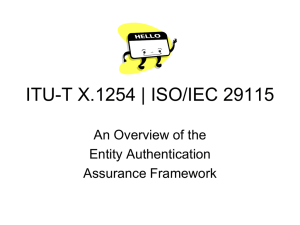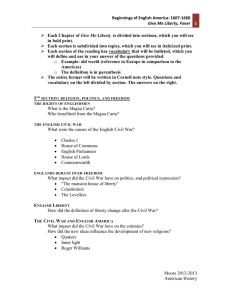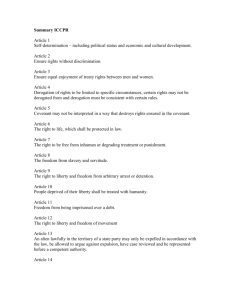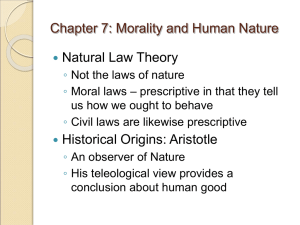Liberty Alliance
advertisement
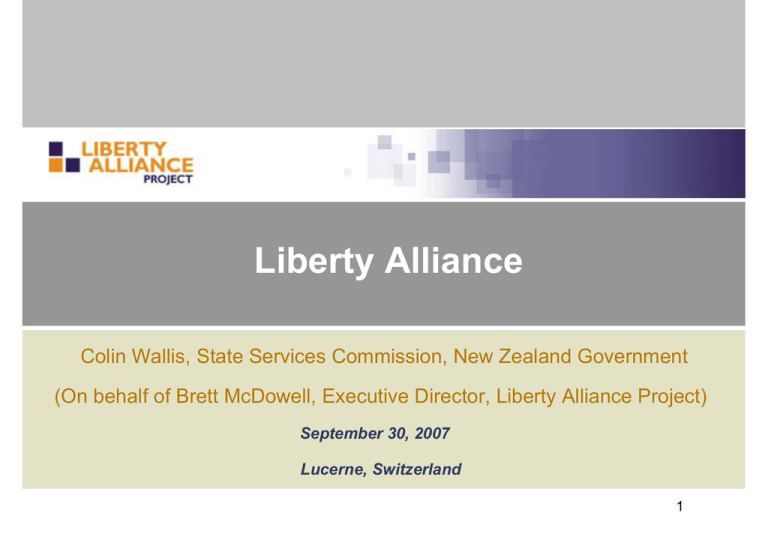
Liberty Alliance Colin Wallis, State Services Commission, New Zealand Government (On behalf of Brett McDowell, Executive Director, Liberty Alliance Project) September 30, 2007 Lucerne, Switzerland 1 Who is Liberty Alliance? 150 diverse member companies and organizations representing leaders in IT, mobility, government, service provision, system integration and finance working collaboratively to address the technology, business and policy aspects of digital identity management Management Board Members include… 3 Who is implementing our standards? 4 Who is deploying?: One Billion and Growing see - http://projectliberty.org/index.php/liberty/adoption More than one billion Libertyenabled identities and devices in the marketplace today… The de-facto standard for Identity Federation Organizations moving from early deployment strategies to mapping ROI “…authentication integrated into a centralized identity management system is about one fourth the cost.” “…Liberty Federation has reduced the cost of manual transactions in the Finland Tax Office to approximately 10-50 cents, representing a cost savings of upwards of 95%” “…T-Online found that ‘each click a user was required to make reduced usage by 10%.’ Federation has 5 reduced the required number of “clicks.” Concordia Brings Together Disparate Initiatives 6 What The Industry Needs Ubiquitous, interoperable, privacy-respecting, identity layer: Liberty represents all constituencies toward this objective (vendors, enterprise, government, consumers, universities, SME’s, etc.) Must be an open, collaborative system vs. single vendor strategy Identity is important & complex. We must come together OR: industry will become more fractured governments will intervene Privacy-compliant practices to exchange identity information Standards-based model to … Interoperate in heterogeneous environments Avoid proprietary vendor lock-in Provide flexible foundation for future growth Scale to the WWW Consumer & enterprise confidence that security, privacy and data integrity will be maintained. 7 Moving the Industry Forward 8 What Liberty is Doing about it Technology Standards and Guidelines Business and Privacy Guidelines Trust An Ecosystem of Interoperable Products & Services Liberty helps organizations build a foundation for trust -- critical for the overall success of identity-based services and efficiencies What's the Problem? Barriers persist for widespread deployment: Standards confusion exists Identity agent interoperability (SAML, OpenID, Cardspace, Higgins etc) Inter-organizational “trust” is hard to scale Enterprises are struggling to comply with “consent” regulation The market is confused Enterprise PoC's are non-trivial to stand up What is Liberty doing to overcome these?... 10 Identity Management can not be an afterthought It will take time to build the right capabilities Identity Assurance Expert Group (IAEG) Newly formed Identity Assurance Expert Group (IAEG) designed to foster adoption of identity assurance services Initial contributions from EAP and U.S. E-Authentication Federation Objective is to create a framework of baseline policies, business rules and commercial terms against which identity assurance services can be assessed and certified Goal is to facilitate trusted identity federation to promote uniformity and interoperability amongst identity service providers 12 Identity Assurance Trust Framework Utilizes EAP Trust Framework and US e-Authentication Federation Credential Assessment Framework as a baseline Harmonized, best-of-breed industry identity assurance standard Framework supporting mutual acceptance, validation and lifecycle maintenance across identity federations Framework consists of: Business Rules Assurance Levels Service Assessment Criteria Accreditation and Certification Model 13 Trust Framework Business Rules Focused on the use of credentials for authentication, with the initial phase targeting Identity Providers (IDPs) IAEG provides accreditation of assessors who will perform certification assessment Federation Operators will make ultimate IAEG-certification decision based on findings of accredited assessors Relying Parties agree to abide by IAEG framework and have agreements in place with CSPs, accordingly IAEG will maintain relevance of the Trust Framework criteria and provide an updated list of accredited and certified providers 14 Trust Framework Assurance Levels Policy Overview Level of trust associated with a credential measured by the strength and rigor of the identity-proofing process,the inherent strength of the credential and the policy and practice statements employed by the service provider Four Primary Levels of Assurance Level 1 – little or no confidence in asserted identity’s validity Level 2 – Some confidence Level 3 – High level of confidence Level 4 – Very high level of confidence Use of Assurance Level is determined by level of authentication necessary to mitigate risk in the transaction, as determined by the Relying Party CSPs are certified by Federation Operators to a specific Level(s) Trust Framework Assurance Levels Assurance level criteria as posited by the OMB M-0404 and NIST Special Publication 800-63: Level 1 – (e.g. registration to a news website) Satisfied by a wide range of technologies, including PINs Does not require use of cryptographic methods Level 2 – (e.g. change of address by beneficiary) Single-factor remote network authentication Claimant must prove control of token through secure authentication protocol Level 3 – (e.g. online access to a brokerage account) Multi-factor remote network authentication Authentication by keys through cryptographic protocol Tokens can be “soft”, “hard” or “one-time password” Level 4 – (e.g. dispensation of controlled drugs; $1mm wire) Multi-factor remote authentication through “hard” tokens Transactions are cryptographically authenticated using keys bound to the authentication process Service Assessment Criteria (SAC) Common Organization SAC - The general business and organizational conformity of services and their providers Enterprise maturity; Information Security Mgmt; Operational Infrastructure, etc. Identity Proofing SAC - The functional conformity of identity proofing services Identity verification; Verification records Credential Management SAC - The functional conformity of credential management services and their providers Operating environment; Issuance; Revocation; Status Mgmt; Validation/Authentication Credential Assessment Profiles Description / Criteria Maturity of Operations Business Continuity Planning Information Security policies and practices Network and system security Interoperability with authentication systems (i.e. e-Auth) Credential strength Subscriber agreements Rigor of Registration and Record Retention policies CAP Development Process for reviewing and approving new CAPs to keep up with technological advances CAP Maintenance Process by which IAEG maintains the currency of CAPs Identity Assurance Certification Model Program for auditors to execute certification/accreditation process Provide Identity Assurance service providers with guidelines for certifying to Liberty Alliance IAEG Federations certifying their members for the benefit of inter-federation and streamlining the certification process for the industry Liberty Alliance IAEG to provide governance over certification process Phase 1 = Identity Providers Phase 2 & 3 = Relying Parties and Federation Operators 19 Reference Documents EAP Trust Framework OMB e-Authentication Guidance (OMB M-04-04) NIST Special Publication 800-63 Version 1.0.1 Authentication Service Component Interface Specifications GSA Credential Assessment Framework, Password CAP, Certificate CAP and Entropy Spreadsheet Questions Contact: Brett McDowell, Executive Director, brett@projectliberty.org (+1.413.662.2744) 21 How Do We Get Things Done? 22 Potential Unification Touch Points “ Eve Maler, Sun Microsystems Liberty’s Identity Web Services How to address the new challenges Introducing The Concordia Project A new program designed to drive interoperability throughout the Internet Identity Layer Global, cross-initiative collaboration A public call for interop use cases for heterogeneous environments Expansion of Liberty’s interoperability testing to meet new and varied requirements Open source support for relying parties Concordia Components Open Wiki: http://www.projectconcordia.org Events IOS, IIW, Catalyst, DIDW, etc. Use case definitions More than 20 submissions, including detailed use cases from AOL, Boeing, GM, Government of British Columbia, and the US GSA Future Interop Event(s) Specification work to be done in appropriate standards bodies Future Certification Program Support from Liberty Alliance 26 IGF to help industry meet regulation Increasing legal and regulatory concern about access to identityrelated data about users Privacy concerns: HIPAA, SB 1386, theft of user data Compliance: SOX, GLB, EU legislation Who has access to my social security number or account number, and, under what conditions? Effective business applications require flexible access to data about users Value of data held by enterprise lies in its use! Application developers should focus on business requirements not on protocols or identity stores CHALLENGE: Need an enterprise-wide framework for managing access to identity-related data provided by multiple sources Identity Governance Framework CARML – Defines application identity requirements • what identity information an application needs and how the application will use it. AAPML – Defines identity use policies (XACML) • Constraints on user and application access to personal data • obligations and conditions under which data is to be released Attribute Service – Links applications to identity data Developer APIs/Tools – Developers can express identity requirements at a business level at development time • Key to IGF adoption/use



